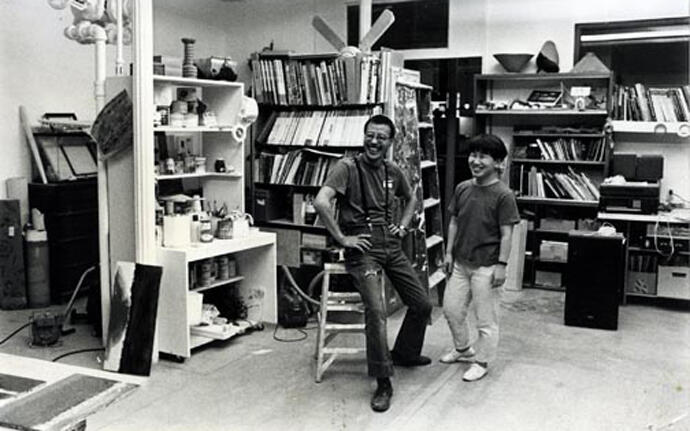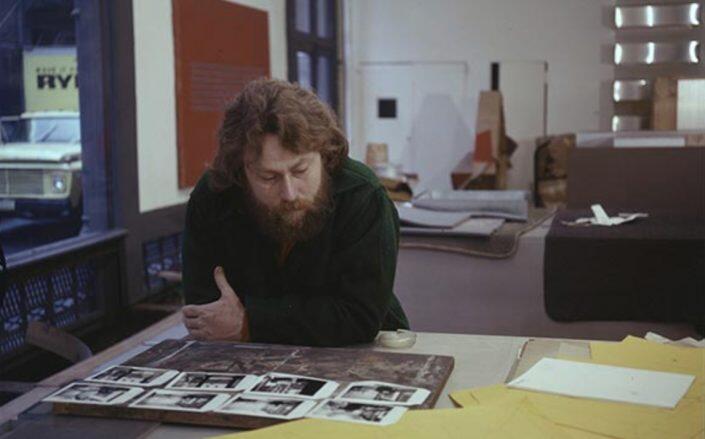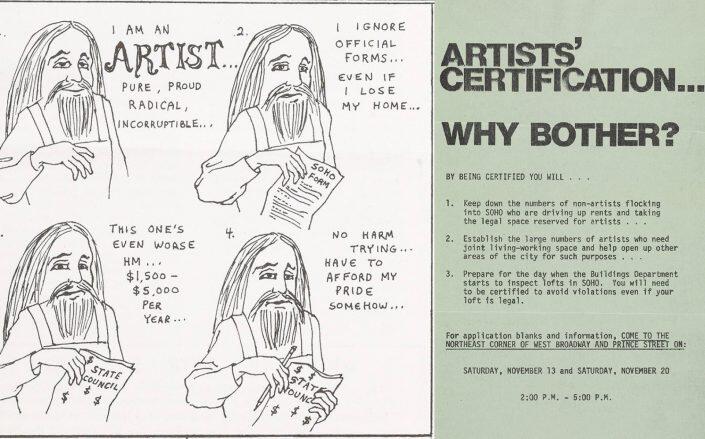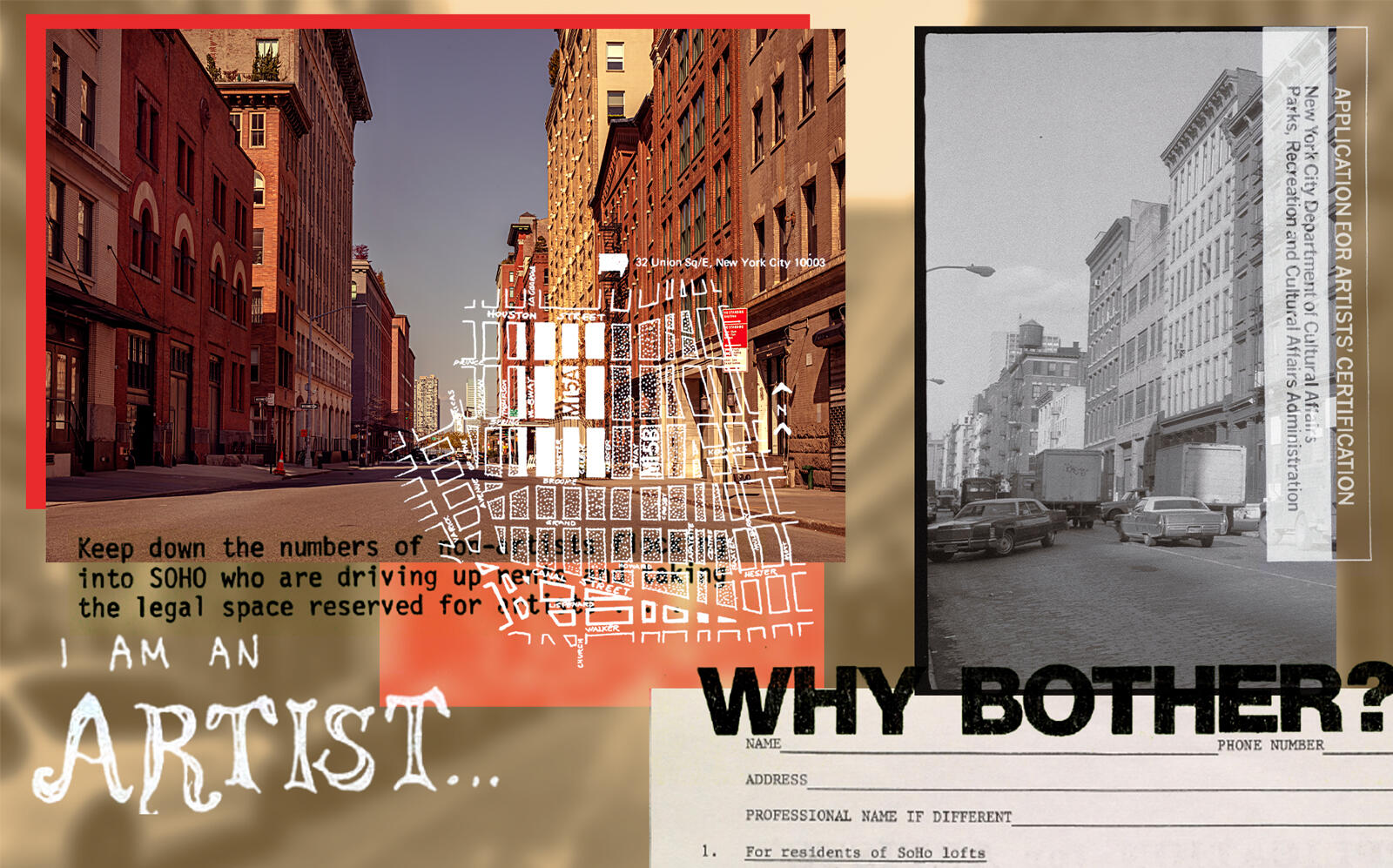Ichiro Ohta held his 3-month-old daughter up to the window so she could see the astronauts. Ticker tape rained down over Buzz Aldrin and Neil Armstrong as the Apollo 11 parade rolled over the cobblestone below his bare-bones Soho loft.
It was August 1969, and Soho was not yet Soho. Ohta was one of the pioneers.
Today, Yukie Ohta still lives in the same apartment with the huge glass panes where her father showed her the moonmen. He was a painter and a carpenter, making the emptied-out, post-industrial neighborhood perfect for pursuing his passion and his business all under one roof. He had moved to New York in 1965, taking over the loft from a friend who was returning to Japan.

Yukie Ohta’s parents in their Soho loft (Soho Memory Project)
He came to America “when sushi was discovered by the United States,” his daughter jokes. With all things Japanese en vogue, Ichiro found success building out sushi restaurants and painting lacquer screens, thanks to the expansive workspace his loft afforded. Had he lived anywhere else, he would have had to also rent a studio.
“For artists like the ones who came to Soho, there wasn’t a line that delineated the area they were working and living,” said Ohta. Hundreds of artists like her father moved into the old garment factories, drawn by their tall ceilings and natural light, jamming art and work and family all into one big, illegal apartment.
Soho was zoned for industrial use, a vestige of its years as New York’s manufacturing hub. The sweatshops were mostly gone by the end of World War II, but when artists began occupying those spaces in the 1960s, they did so in defiance of city regulations.
Soho has since been transformed again, becoming one of the world’s premier shopping districts and the wealthiest neighborhood in the entire city. Yet Soho’s zoning stayed basically the same. When Ohta wakes up just steps from the window where she made her first Soho memory, she is technically breaking the rules.
For everyone from artists to businesspeople, developers to tenants, Soho’s zoning code is woefully out of sync with the neighborhood it aims to govern. It has been for decades. But now, just before a new administration steps into City Hall, city planners are fighting to squeeze through a rezoning that they say would finally match code with reality.
This has triggered a major fight in the neighborhood over development and affordability, one that has overshadowed another important part planners’ effort — to correct the decades’ worth of decisions that pushed Soho’s zoning so far off course in the first place.
Catching fire
When he wasn’t busy reinventing American classical music, Philip Glass moonlighted as the most famous plumber in Soho.
In the 1960s, intrepid artists began squatting in the neighborhood’s abandoned cast-iron factories. The former sweatshops had high ceilings and plenty of natural lighting, which made them perfect incubators for experimental sculptors including Donald Judd, whose geometric stacks could climb 17 feet tall.

Donald Judd (Judd Foundation)
But many were missing modern plumbing or electricity. Some artists tried rigging their own facilities, and Glass and his cousin made a business out of helping them. With some elbow grease, the old garment factories morphed into live–work spaces that eventually became some of the most coveted real estate anywhere.
It was a chance crossing of culture and opportunity: As aesthetic preferences drifted toward the industrial, a glut of abandoned factory spaces downtown laid in disuse. Tired of paying top dollar for uptown shoeboxes near the city’s prevailing galleries, New York’s artistic vanguard moved south.
While the buildings were relatively easy to occupy, they also proved treacherous.
Nicknamed “Hell’s Hundred Acres,” Soho had a fire problem. Its aging factories typically lacked modern sprinkler systems and fireproofing, and with unknown numbers of people suddenly occupying vacant lofts without registration, blazes turned from destructive to deadly.
Firefighters had no idea which burning buildings might have people trapped inside. A series of deadly blazes soon made evident the need for some kind of formal recognition from the city. In 1961, a group of squatters formed the Artists Tenants Association, in large part to lobby for protections from such disasters.
Later that year, the city established its Artist in Residence policy, its first official recognition that artists were living in Soho’s industrial spaces. The policy was “a way to let people live illegally in an organized way,” says Aaron Shkuda, a Princeton historian and the author of The Lofts of Soho: Gentrification, Art, and Industry in New York, 1950–1980. Artists living in lofts were required to hang black signs on their doors that read A.I.R. (artist in residence) so that first responders could find people faster.
Even though the policy was a lifesaving, fairly non-invasive measure, not everyone was happy about it. “There was the sense from very early on that the more you make this legal and regular, the more people are going to be attracted to living there,” said Shkuda.
With regulation comes attention. With attention comes money, development and non-artists. Soho may have been a dumpster fire, but at least it was their dumpster fire.
Soho grows up
By 1970, laissez-faire Soho couldn’t be sustained. That year, influential curator Leo Castelli moved his gallery from the Upper East Side down to 420 Broadway. It was “the moment when the established art world had a beachhead in Soho,” Shkuda said.
With a growing number of people living illegally in the old factories, and nothing more than black placards to protect them, the City Planning Commission proposed a zoning amendment for the neighborhood.
Looking to maintain Soho’s historic character, the city moved to establish M1-5A and M1-5B zoning districts in Soho. The new designations kept the area zoned for manufacturing and light industrial use, but carved out a unique workaround for artists to continue living in upper-floor lofts.
The codes tasked the Department of Cultural Affairs with issuing certificates that confirmed someone was indeed an artist. The certification qualified loft-dwellers for “joint living-work quarters” (granted the appropriately cumbersome acronym JLWQA), which were the same lofts they were already in. The city justified this by claiming the artists were engaging in light industrial work, as they often used power tools and manufacturing gear to fashion their sculptures and paintings.
Records suggest that the program opened to apathy more than anything else. In a June 1971 press release, the Department of Cultural Affairs announced it had certified the first 22 artists to live in joint live-work quarters. However, more recent data provided by the city show only 28 acceptances in the program’s first five years.
In the first month of a “massive accreditation drive,” only 100 artists signed up for certification, according to an early edition of the Soho Artists Association’s newsletter, which called attention to the issue with commentaries like the one shown here. The adjacent flyer from the Artists’ Certification Committee raised a common question at the time: why bother getting certified?

Even though only artists were allowed to live in the converted lofts, other people moved in, enticed by the neighborhood’s growing cultural cachet. By 1976, prices for residential lofts began to exceed those for industrial space in Soho, according to Shkuda.
The artist certification process finally picked up steam when a series of Loft Laws passed in the early 1980s. These granted amnesty to anyone occupying a loft illegally in the city, artist or not, if the unit were brought up to minimum living safety code. The laws also granted rent stabilization to many existing JLWQA tenants.
In its heyday of the 1980s, the department certified almost 400 artists a year, and people flowed into Soho. Yet city planners stood pat.
“Soho zoning codes,” said Shkuda, “came about as a historical accident.”
Soho today
Ichiro Ohta became a certified artist and kept his loft according to the city’s new guidelines. He lived there for decades, and after brief stints in “such exotic places as Morningside Heights,” Yukie and her husband moved back in with her parents to raise their child. Her parents have since moved out, but not Yukie. Neither she nor her husband are certified artists.
“That idea of being certified and legal as artists went out the window early on, when the city did not enforce the requirement,” said Ohta.
The city earmarks 32 percent of Soho’s 5,100 units as live-work spaces for certified artists. Yet in the past decade, the Department of Cultural Affairs has only certified 98 artists.
There is a “mismatch between the 50-year-old zoning and the existing conditions in those neighborhoods today,” Erik Botsford, a deputy director at the Department of City Planning, explained in what can safely be described as an extreme understatement.
Four in 10 Soho residents make over $200,000 a year — almost twice as many as in Manhattan as a whole. About half of Soho residents own their apartment, giving it one of the city’s lowest concentrations of rent-burdened residents, or people who spend 35 percent or more of their income on rent. It’s the most educated area in the city — 4 in 5 residents hold at least a bachelor’s degree — and among the whitest, at 78 percent Caucasian.
Read more


Despite the certified artist requirement, lax enforcement has allowed wealthy non-artists to move to the neighborhood en masse, spending millions of dollars on lofts that only a few decades ago didn’t even have running water.
At the same time, artist certifications have essentially ceased. There were none in 2018 or 2019.
Setting aside units for a single profession is rare, but not unique. As zoning codes began to proliferate in the early 20th century, many cities included wording that allowed overnight watchmen to live in industrial facilities. They lived in residential units within industrially zoned buildings to protect valuable equipment when the factory was closed, according to David Morley, a researcher at the American Planning Association.
“Zoning for live-work spaces is relatively common across the country,” Morley said, though he doesn’t know of other cities that use the same government-certification mechanism as Soho.
A handful of other American cities offer housing assistance to certified artists, but only Boston goes as far as Soho in setting aside units for them — 18 buildings across 10 Boston neighborhoods.
However, New York’s certification process requires letters of recommendation, professional reviews or exhibition announcements, and a portfolio of best works. Materials are reviewed by an anonymous board, which for half a decade has been New York’s unilateral arbiter of what defines an “artist.”
Not just housing
Just as Soho has become an exclusive residential neighborhood, it has experienced a retail and commercial boom. Today, only 2 percent of the 53,000 jobs in the rezoning area are industrial. Half are office jobs, mainly in the fashion, design and creative spaces.
Another fifth of the area’s jobs are in retail, which reflects Soho’s relatively new status as a premier shopping destination. The shops that line its streets took in $3.1 billion in 2016, and collect $170 million in sales taxes each year. Soho ranked second in sales in the city and in the top 10 for shopping districts nationally.
Yet retail still is not allowed as-of-right on the ground floor of most Soho buildings. Instead, businesses must go through an expensive, onerous, and drawn-out permitting process.
Though there are workarounds, none make much sense for the city or business owners.
One, known as a “Good Faith Marketing Effort Special Permit,” requires building owners to keep the ground floor vacant for up to a year, proving that no industrial tenants want the space. After earning a permit, they must slog through the city’s land-use review procedure, which takes the better part of a year.
The city aims to address these mismatches as part of its controversial rezoning proposal. The plan, which city planners hope to see approved by year-end, would preserve protections for existing joint live-work quarters.
While it wouldn’t push artists out, it would entice them to leave — and undo their obscure zoning status. The plan would create a legal pathway for certified artists to sell or transfer ownership of their lofts to non-artists. City planners are proposing a mandatory “contribution” of $100 per square foot on any live-work space converted to regular residential use. The tax would create an arts fund that is short on specifics but bold in its ambitions.
Planning is working with the Department of Cultural Affairs to build a program that would benefit up-and-coming artists in Soho, Botsford said. Funds would go to local arts groups, maintaining the neighborhood’s artistic clout even as white-collars move in. Because live-work quarters must be at least 1,200 square feet, and often exceed 3,000, contributions would routinely break six digits — enough to yield a well-heeled support fund.
Some rent-controlled JLWQA dwellers have expressed concerns in planning meetings that owners will pressure them to move out, opening their space for market-rate apartments. The city has pushed back, promising tenant intimidation protections. “Nothing will change for existing artists that are remaining in the neighborhood today,” says Botsford.
The new code would also open up ground floors for retail shops, restaurants and museums as-of-right.
If passed, the plan would be a rare city upzoning of a wealthy, super-majority-white neighborhood. As it moves through the seven-month review process, it faces opposition from highly organized opposition groups who say they want to preserve Soho’s historic character. But it is fair to ask how much of that scrappy, rig-up-your-plumbing character even remains.
Yukie Ohta did not comment on the rezoning proposal, deferring to those more deeply involved. But for the longtime resident who has witnessed Soho’s evolution firsthand, one thing is painfully obvious.
“There’s no way, unless you’re already successful, that an artist can move in now,” she said.
